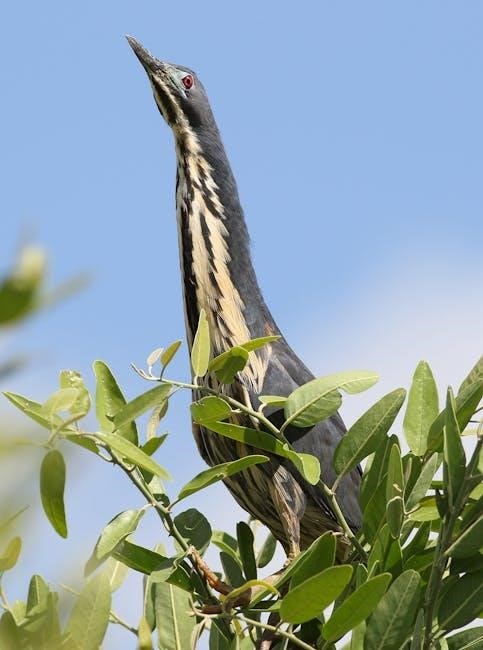
“The Conference of the Birds” by Farid ud-Din Attar is a 12th-century Persian allegorical poem. It explores themes of spirituality, self-discovery, and enlightenment through the journey of birds seeking the Simurgh, symbolizing divine truth. Rich in metaphors and Sufi mysticism, the poem remains a timeless masterpiece of Persian literature, offering profound insights into human existence and spiritual growth. Its availability in PDF formats has made it accessible to global readers, ensuring its enduring relevance and inspiration.
1.1 Overview of the Poem
“The Conference of the Birds” is a captivating Persian poem by Farid ud-Din Attar, written in lyrical verse. It tells the story of a gathering of birds who embark on a spiritual journey under the guidance of the hoopoe to find the Simurgh, a mythical king. The poem is structured as a series of allegorical tales, each highlighting the birds’ struggles and revelations. Through its intricate narrative and profound symbolism, Attar explores themes of spirituality, self-discovery, and the pursuit of enlightenment, making it a timeless work of Sufi literature.
1.2 Historical Context and Significance
“The Conference of the Birds” was written in the 12th century by Farid ud-Din Attar, a renowned Persian poet and Sufi mystic. The poem reflects the spiritual and cultural ethos of its time, blending Islamic mysticism with Persian literary traditions. It gained prominence for its profound exploration of Sufi doctrines and its allegorical storytelling. The work is considered a cornerstone of Persian literature, influencing countless writers and thinkers. Its historical significance lies in its enduring themes of spirituality and self-discovery, resonating across cultures and centuries, and remains a vital text in Sufi studies and world literature.
1.3 Themes and Symbolism in the Poem
“The Conference of the Birds” is rich in themes of spirituality, self-discovery, and enlightenment. The poem uses the allegory of birds embarking on a journey to find the Simurgh, symbolizing the divine truth. Each bird represents a human trait or flaw, highlighting the challenges of the spiritual path. The journey itself is a metaphor for the soul’s quest for unity with the divine. The poem’s symbolism, deeply rooted in Sufi mysticism, explores themes of love, sacrifice, and the transcendence of the ego. Its universal themes continue to resonate, making it a timeless spiritual guide.

The Structure and Style of the Poem
The poem employs an allegorical structure, following birds on a symbolic journey. Written in rhyming couplets, it blends lyrical elegance with profound spiritual insights, reflecting Persian poetic traditions.
2.1 Narrative Structure and Flow
The poem’s narrative structure follows the birds’ journey to find the Simurgh, organized into sequential episodes. Each episode presents challenges and moral lessons, maintaining a fluid progression that builds towards the climax. The allegorical framework supports themes of perseverance and unity, enhancing the emotional and spiritual impact. This structure effectively conveys abstract concepts through relatable experiences, making the pursuit of truth and enlightenment accessible and engaging for readers.
2.2 Use of Allegory and Metaphor
The poem employs allegory and metaphor to convey profound spiritual truths. The birds symbolize human souls, while their journey represents the quest for divine truth. Attar uses the Simurgh as a metaphor for the ultimate reality, emphasizing unity and self-discovery. Each bird’s story serves as an allegory for human flaws and virtues, illustrating the challenges of the spiritual path. These literary devices create a layered narrative, allowing readers to interpret the text on both literal and symbolic levels, enriching its depth and universal appeal.
2.3 Poetic Devices and Language
Attar masterfully employs a range of poetic devices, including rhyme, rhythm, and repetition, to create a lyrical and immersive experience. His use of vivid imagery and symbolism enhances the emotional and spiritual depth of the narrative. The language is both elegant and accessible, reflecting the cultural richness of Persian poetry. Through these techniques, Attar conveys complex philosophical ideas in a way that resonates with readers, making the poem both artistically beautiful and intellectually profound. This blend of style and substance ensures its enduring literary significance.
The Conference of the Birds as a Central Motif
The poem’s central motif revolves around the birds’ gathering and their perilous quest to find the Simurgh, symbolizing unity, leadership, and the pursuit of divine truth.

3.1 The Journey of the Birds
The birds’ journey is a metaphor for the human quest for enlightenment. Led by the hoopoe, they face numerous challenges, each representing moral and spiritual dilemmas. Through perseverance, they overcome obstacles, symbolizing the path to self-discovery and divine truth. The journey reflects Sufi principles, emphasizing unity and the pursuit of wisdom. Available in PDF, the poem’s timeless themes resonate globally, offering insights into spirituality and personal growth. Its allegorical nature continues to inspire readers, making it a cherished literary masterpiece.
3.2 The Role of the Hoopoe
The hoopoe, as the leader of the birds, embodies wisdom and spiritual guidance. Its role is pivotal in initiating and directing the journey to the Simurgh, symbolizing divine truth. The hoopoe’s unwavering commitment and knowledge inspire the birds to persevere through their quest. Its leadership highlights the importance of guidance in spiritual journeys, reflecting Sufi ideals of mentorship and enlightenment. Available in PDF, the poem underscores the hoopoe’s significance as a symbol of insight and divine connection, making it a central figure in the narrative’s exploration of spirituality and self-discovery.

3.3 The Symbolism of the Simurgh
The Simurgh, a majestic mythical bird, symbolizes divine truth and enlightenment in “The Conference of the Birds.” Representing the ultimate reality, it embodies the unity and transcendence sought by the birds. The name “Simurgh” reflects the Persian phrase for “thirty birds,” signifying the collective soul’s journey toward divine understanding. Through its enigmatic presence, the Simurgh guides the birds to self-realization, illustrating Sufi ideals of spiritual awakening. Its imagery in the poem underscores the quest for meaning and connection to the divine, resonating deeply in PDF versions of the text, which preserve its timeless essence for modern readers.

Philosophical and Spiritual Themes
“The Conference of the Birds” delves into profound Sufi mysticism, exploring themes of self-discovery, divine unity, and the journey of the soul toward enlightenment and truth.
4.1 Sufi Mysticism and Its Influence

“The Conference of the Birds” is a masterpiece of Sufi literature, reflecting the mystical journey of the soul toward divine unity. Attar’s allegory captures the essence of Sufi teachings, emphasizing love, self-sacrifice, and spiritual purification. The hoopoe guides the birds, symbolizing the Sufi guide or sheikh, while their challenges mirror the seeker’s trials on the path to enlightenment. The poem’s profound themes resonate deeply, influencing spiritual thought across cultures and centuries, making it a cornerstone of Sufi mysticism and a timeless inspiration for seekers of truth and divine connection.
4.2 The Concept of Self-Discovery
“The Conference of the Birds” profoundly explores the theme of self-discovery through the allegorical journey of the birds. Each bird represents a human trait, and their quest for the Simurgh symbolizes the search for inner truth. Attar’s poem illustrates how self-discovery involves confronting one’s flaws, letting go of ego, and embracing humility. The birds’ challenges mirror the spiritual seeker’s journey, highlighting the importance of introspection and perseverance. Ultimately, the poem reveals that true understanding lies within, making it a powerful guide for those seeking self-awareness and spiritual growth.
4.3 The Quest for Enlightenment
The poem masterfully depicts the quest for enlightenment through the birds’ arduous journey to find the Simurgh. Each challenge they face symbolizes the spiritual obstacles humans must overcome. Attar emphasizes the importance of perseverance, self-reflection, and unity with the divine. The birds’ ultimate realization—that they themselves are the Simurgh—illuminates the idea that enlightenment lies within. This profound message, available in PDF editions, continues to inspire seekers of truth, offering timeless wisdom on the path to spiritual awakening and the attainment of higher consciousness. The journey remains a universal metaphor for the human quest for meaning and transcendence.
Cultural and Historical Impact
“The Conference of the Birds” has profoundly influenced Persian literature and Sufi thought, gaining global recognition. Its themes of unity and divine truth resonate universally, ensuring its enduring legacy through PDF versions that spread its teachings worldwide.
5;1 Influence on Persian Literature
“The Conference of the Birds” holds a revered position in Persian literature, inspiring generations with its profound spiritual and philosophical themes. Attar’s masterful use of allegory and metaphor has influenced countless poets and writers, shaping the literary landscape. The poem’s exploration of Sufi mysticism and self-discovery resonated deeply, making it a cornerstone of Persian cultural heritage. Its availability in PDF formats has further ensured its reach, allowing modern readers to engage with this timeless masterpiece and appreciate its enduring impact on literary traditions.
5.2 Reception in the Islamic World
“The Conference of the Birds” has been warmly received in the Islamic world, resonating deeply with Sufi principles and Islamic spirituality. Its exploration of self-discovery and divine truth aligns with mystical Islamic traditions, making it a cherished text among scholars and the faithful alike. The poem’s influence extends to Islamic literature and thought, with its themes inspiring further works and discussions. Its accessibility in PDF formats has only enhanced its presence in contemporary Islamic discourse, ensuring its enduring relevance and appreciation.
5.3 Global Recognition and Adaptations
“The Conference of the Birds” has gained global acclaim for its universal themes of spirituality and self-discovery. Translated into numerous languages, it has inspired adaptations in literature, art, and theater worldwide. Its PDF versions have facilitated easy access, making it a popular study material in universities. The poem’s allegorical nature resonates across cultures, fostering cross-cultural dialogue and appreciation. Its influence extends beyond Persian literature, shaping global perspectives on mysticism and enlightenment, while its timeless wisdom continues to captivate readers and scholars internationally.

Analysis of Key Characters

The poem’s characters, like the hoopoe and the nightingale, symbolize diverse human traits and spiritual journeys, offering profound lessons on perseverance, love, and self-discovery.
6.1 The Leadership of the Hoopoe
The hoopoe emerges as a wise and compassionate leader, guiding the birds on their arduous journey to the Simurgh. With its profound understanding and poetic insight, it motivates the flock, addressing their fears and doubts. The hoopoe’s leadership embodies the Sufi ideal of a spiritual guide, offering wisdom and encouragement. Its role is pivotal in maintaining unity and focus among the diverse birds, symbolizing the challenges and rewards of collective spiritual endeavor. Through its leadership, the hoopoe exemplifies the qualities of perseverance, empathy, and divine inspiration.
6.2 The Role of the Nightingale
The nightingale in “The Conference of the Birds” symbolizes the soul’s longing for divine love and beauty. Its enchanting song represents the call of the spiritual world, drawing the birds toward their quest. The nightingale’s passion reflects the human experience of emotional and spiritual yearning, illustrating the transformative power of love. Through its character, Attar highlights the importance of devotion and the pursuit of the divine, making the nightingale a poignant reminder of the heart’s capacity for profound connection and transcendence, central to Sufi mysticism and the poem’s thematic depth.
6.3 The Significance of the Falcon
The falcon in “The Conference of the Birds” symbolizes kingship, divine guidance, and leadership. Its presence underscores themes of authority and humility, as it reluctantly accepts the role of guiding the birds toward the Simurgh. The falcon’s wisdom and nobility make it a crucial figure in the journey, representing the balance between power and humility; Its character serves as a metaphor for the spiritual leader who guides seekers of truth, embodying the ideals of Sufi mysticism. The falcon’s role highlights the importance of selfless leadership in the quest for enlightenment and divine connection.

The Poem’s Relevance in Modern Times
“The Conference of the Birds” remains relevant in modern times, offering timeless themes of self-discovery and enlightenment through accessible PDF versions, used in spirituality and education.
7.1 Universal Themes and Messages
“The Conference of the Birds” delves into universal themes such as self-discovery, unity, and the pursuit of truth. These timeless messages resonate across cultures and generations, emphasizing perseverance and spiritual growth. The poem’s exploration of existential questions and human nature remains deeply relevant in modern times. Its allegorical storytelling transcends time, offering insights into personal and collective journeys. The PDF versions of the poem have made these universal themes accessible to a global audience, fostering reflection and inspiration in contemporary spirituality and education.
7.2 Applications in Modern Spirituality
The universal themes of “The Conference of the Birds” resonate deeply in modern spirituality, offering guidance on self-reflection and inner peace. The poem’s allegorical journey mirrors contemporary mindfulness practices, encouraging individuals to seek their true selves. Its emphasis on perseverance, unity, and divine connection inspires modern spiritual seekers. The availability of the poem in PDF formats has further expanded its reach, making its timeless wisdom accessible to those exploring personal growth and spiritual enlightenment in today’s fast-paced world.
7.3 Educational Value and Use in Academia
“The Conference of the Birds” holds significant educational value, offering insights into Persian literature, Sufi mysticism, and cross-cultural themes. Its allegorical structure makes it a rich text for analyzing symbolism and metaphorical language. Academics often use the poem to teach critical thinking, comparative religion, and Middle Eastern studies. The availability of the poem in PDF formats has facilitated its inclusion in curriculum designs worldwide, enabling students and scholars to explore its profound themes and historical context with ease and accessibility.
Resources and References
Access “The Conference of the Birds” PDF through official websites, academic databases, and libraries. Explore editions on JSTOR, Google Scholar, and online archives for comprehensive study.
8.1 Availability of the PDF Version
The PDF version of “The Conference of the Birds” is widely available for download through various platforms. Official websites, academic databases, and libraries often provide free access to this literary masterpiece. E-book platforms like Google Books and Project Gutenberg also offer downloadable versions. Additionally, many publishers distribute PDF editions, which can be purchased or accessed through subscriptions. These resources ensure that readers can easily obtain and study the poem in a digital format, facilitating both academic and personal exploration of its profound themes and allegorical content.

8.2 Recommended Translations and Editions
The most acclaimed English translations of “The Conference of the Birds” include those by Dick Davis and Sholeh Wolpé, praised for their fidelity to the original Persian text and lyrical quality. Penguin Classics and HarperOne offer highly recommended editions, featuring comprehensive introductions and annotations. These translations capture the poem’s spiritual depth and allegorical richness, making them accessible to modern readers. For scholars and enthusiasts alike, these editions are indispensable for understanding Attar’s masterpiece in its full complexity and beauty.
8.3 Online Resources and Study Guides
Various online platforms offer study guides and resources for understanding “The Conference of the Birds.” Websites like JSTOR and Google Scholar provide academic articles and analyses. Educational sites such as SparkNotes and LitCharts offer summaries and thematic breakdowns. Additionally, online courses on Persian literature from platforms like Coursera feature discussions on Attar’s work. University lecture notes and PDF guides are also available, offering insights into the poem’s historical context and Sufi themes. These resources cater to both casual readers and scholars, enhancing comprehension of the poem’s depth and significance.
Leave a Reply
You must be logged in to post a comment.